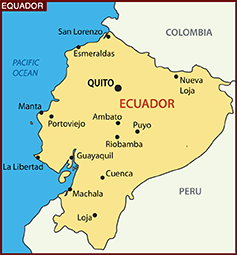Pharmacoeconomic Guidelines: Ecuador
Country/Region: Ecuador

Published PE Recommendations
Published PE Recommendations Source:
Ecuadorian Ministry of Health
Additional Information:
Developed by the National Health Economics Office
Information current as of Wednesday, February 7, 2024
Key Features
| Key Features | |
|---|---|
| Type of Guidelines | Published PE Recommendations |
| Title and year of the document | Metodología para la elaboración de evaluaciones económicas de tecnologías sanitarias para la Red Pública Integral de Salud (2022) |
| Affiliation of authors | Ministry of Health |
| Purpose of the document | The purpose of this manual is to guide, with methodological foundations, the development of economic evaluations of health technologies in Ecuador. |
| Standard reporting format included | CHEERS 2022 guidelines recommended. |
| Disclosure | Yes. |
| Target audience of funding/ author's interests | Professionals and researchers who conduct HE evaluations or are interested in developing HE evaluations. |
| Perspective | Healthcare perspective or third-payer perspective preferred. |
| Indication | No. |
| Target population | Clearly described. |
| Subgroup analysis | It is encouraged that analysts conduct subgroup analyses to distinguish effectiveness and costs across heterogenous subgroups. |
| Choice of comparator | Current clinical practice used within the national health system. |
| Time horizon | Sufficiently long to incorporate all relevant outcomes, both clinical and economic, directly attributable to the use of the technology under evaluation. |
| Assumptions required | Yes. |
| Preferred analytical technique | CEA, CUA |
| Costs to be included | Depends on chosen perspective. Payer perspective generally includes related and unrelated direct medical costs. |
| Source of costs | Government databases and other public databases when necessary. |
| Modeling | Yes. |
| Systematic review of evidences | Yes. |
| Preference for effectiveness over efficacy | Yes, where feasible, the results and costs of an economic evaluation should be based on the effectiveness of the intervention, rather than its efficacy, for the evaluation to be relevant. |
| Preferred outcome measure | Effectiveness (e.g. QALY, DALY, HYE) |
| Preferred method to derive utility | EQ-5D (valued using time trade-off or standard gamble) |
| Equity issues stated | Yes. |
| Discounting costs | Base case: 5% (sensitivity analyses: 0%, 3.5%, 7%, 12%) |
| Discounting outcomes | Base case: 5% (sensitivity analyses: 0%, 3.5%, 7%, 12%) |
| Sensitivity analysis-parameters and range | For uncertain relevant parameters (e.g., discount rate, effectiveness, costs), a plausible range must be defined for each parameter based on the empirical literature (clinical trials, observational studies, expert opinion). |
| Sensitivity analysis-methods | One-way, multi-way, probabilistic analysis. |
| Presenting results | CHEERS 2022 guidelines recommended. |
| Incremental analysis | Yes. |
| Total costs vs effectiveness (cost/effectiveness ratio) | Yes. |
| Portability of results (Generalizability) | Yes. |
| Financial impact analysis | No. |
| Mandatory or recommended or voluntary | Recommended |
Acknowledgement: